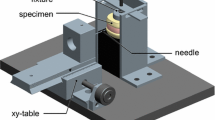Abstract
Objective
To evaluate the feasibility of MR-guided discography using an open 1 Tesla MRI system.
Methods
48 disc segments of 41 patients scheduled for intradiscal thermal treatment, total disc replacement or spondylodesis were examined. A 1.0-T open MRI was used for instrument guidance and imaging. After primary disc puncture under guidance of interactive PDw TSE imaging, 1–2 ml of gadolinium contrast saline mixture was injected into the disc. The occurrence of memory pain during injection was recorded. Axial and sagittal T1w TSE images with and without fat saturation were obtained. All MRI discograms were analysed by two readers, who were blinded to the clinical findings.
Results
Overall, the placement of the puncture needle in the targeted disc was accurate under real-time MR guidance. Injections were technically successful in all cases. No major complications occurred. The mean procedure time was 17 min (range 13–34 min). Image quality of contrast-enhanced MR discograms was excellent when using an optimized gadolinium contrast saline mixture of 1:600. Memory pain was detected in 16 out of 48 affected segments.
Conclusion
MR-guided discography is accurate and safe. Multiplanar dynamic imaging facilitates the puncture of discs and provides high-quality MR discograms.





Similar content being viewed by others
References
Anderson SR, Flanagan B (2000) Discography. Curr Rev Pain 4:345–352
Bogduk N, Modic MT (1996) Lumbar discography. Spine (Phila Pa 1976) 21:402–404
Grasshoff H, Kayser R, Mahlfeld U, Mahlfeld K (2001) Diskography findings and results of percutaneous laser disk decompression (PLDD). Rofo 173:191–194
Weishaupt D, Zanetti M, Hodler J et al (2001) Painful lumbar disk derangement: relevance of endplate abnormalities at MR imaging. Radiology 218:420–427
Derby R, Howard MW, Grant JM, Lettice JJ, Van Peteghem PK, Ryan DP (1999) The ability of pressure-controlled discography to predict surgical and nonsurgical outcomes. Spine (Phila Pa 1976) 24:364–371
Guyer RD, Ohnmeiss DD (2003) Lumbar discography. Spine J 3:11S–27S
Ohtori S, Kinoshita T, Yamashita M et al (2009) Results of surgery for discogenic low back pain: a randomized study using discography versus discoblock for diagnosis. Spine Phila Pa 1976 34:1345–1348
Nawfel RD, Judy PF, Silverman SG, Hooton S, Tuncali K, Adams DF (2000) Patient and personnel exposure during CT fluoroscopy-guided interventional procedures. Radiology 216:180–184
Falco FJ, Moran JG (2003) Lumbar discography using gadolinium in patients with iodine contrast allergy followed by postdiscography computed tomography scan. Spine (Phila Pa 1976) 28:E1–E4
Huang TS, Zucherman JF, Hsu KY, Shapiro M, Lentz D, Gartland J (2002) Gadopentetate dimeglumine as an intradiscal contrast agent. Spine (Phila Pa 1976) 27:839–843
Kluner C, Kivelitz D, Rogalla P, Putzier M, Hamm B, Enzweiler C (2006) Percutaneous discography: comparison of low-dose CT, fluoroscopy and MRI in the diagnosis of lumbar disc disruption. Eur Spine J 15:620–626
Sequeiros RB, Klemola R, Ojala R, Jyrkinen L, Vaara T, Tervonen O (2003) Percutaneous MR-guided discography in a low-field system using optical instrument tracking: a feasibility study. J Magn Reson Imaging 17:214–219
Sequeiros RB, Niinimaki J, Ojala R et al (2006) Magnetic resonance imaging-guided diskography and diagnostic lumbar 0.23 T MRI: an assessment study. Acta Radiol 47:272–280
Streitparth F, Walter T, Wonneberger U et al (2010) Image-guided spinal injection procedures in open high-field MRI with vertical field orientation: feasibility and technical features. Eur Radiol 20:395–403
Streitparth F, Gebauer B, Melcher I et al (2009) MR-guided laser ablation of osteoid osteoma in an open high-field system (1.0 T). Cardiovasc Interv Radiol 32:320–325
Streitparth F, Knobloch G, Balmert D et al (2010) Laser-induced thermotherapy (LITT)-evaluation of a miniaturised applicator and implementation in a 1.0-T high-field open MRI applying a porcine liver model. Eur Radiol. doi:10.1007/s00330-010-1831-6
Ricke J, Thormann M, Ludewig M et al (2010) MR-guided liver tumor ablation employing open high-field 1.0 T MRI for image-guided brachytherapy. Eur Radiol 20:1985–1993
Chopra SS, Rump J, Schmidt SC et al (2009) Imaging sequences for intraoperative MR-guided laparoscopic liver resection in 1.0-T high field open MRI. Eur Radiol 9:2191–2196
Pinkernelle JG, Streitparth F, Rump J, Teichgräber U (2010) Adaptation of a wireless PC mouse for modification of GUI during intervention in an open highfield MRI at 1.0 T. Rofo 182:348–352
Sachs BL, Vanharanta H, Spivey MA et al (1987) Dallas discogram description. A new classification of CT/discography in low-back disorders. Spine (Phila Pa 1976) 12:287–294
Collins CD, Stack JP, O’Connell DJ et al (1990) The role of discography in lumbar disc disease: a comparative study of magnetic resonance imaging and discography. Clin Radiol 42:252–257
Slipman CW, Rogers DP, Isaac Z et al (2002) MR lumbar discography with intradiscal gadolinium in patients with severe anaphylactoid reaction to iodinated contrast material. Pain Med 3:23–29
Kakitsubata Y, Theodorou DJ, Theodorou SJ et al (2003) Magnetic resonance discography in cadavers: tears of the annulus fibrosus. Clin Orthop Relat Res 407:228–240
Wonneberger U, Schnackenburg B, Streitparth F, Walter T, Rump J, Teichgraber UK (2010) Evaluation of magnetic resonance imaging-compatible needles and interactive sequences for musculoskeletal interventions using an open high-field magnetic resonance imaging scanner. Cardiovasc Interv Radiol 33:346–351
Walsh TR, Weinstein JN, Spratt KF, Lehmann TR, Aprill C, Sayre H (1990) Lumbar discography in normal subjects. A controlled, prospective study. J Bone Joint Surg Am 72:1081–1088
Carragee EJ (2000) Is lumbar discography a determinate of discogenic low back pain: provocative discography reconsidered. Curr Rev Pain 4:301–308
Acknowledgments
The authors would like to thank Heidi Kotalla, surgical nurse, and Andreas Thomas, MRI technician, for their collaboration and support.
Author information
Authors and Affiliations
Corresponding author
Rights and permissions
About this article
Cite this article
Streitparth, F., Hartwig, T., Schnackenburg, B. et al. MR-guided discography using an open 1 Tesla MRI system. Eur Radiol 21, 1043–1049 (2011). https://doi.org/10.1007/s00330-010-2011-4
Received:
Revised:
Accepted:
Published:
Issue Date:
DOI: https://doi.org/10.1007/s00330-010-2011-4




